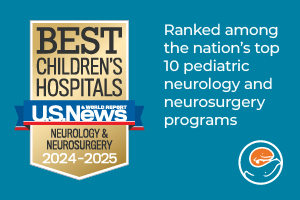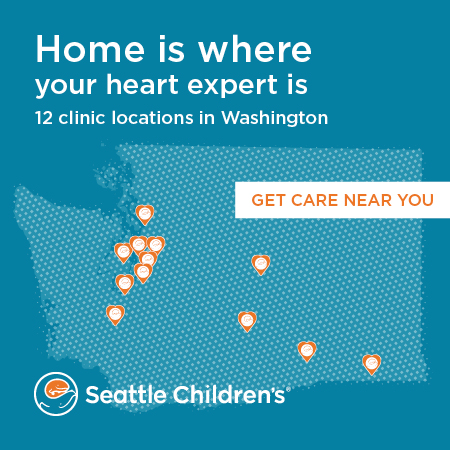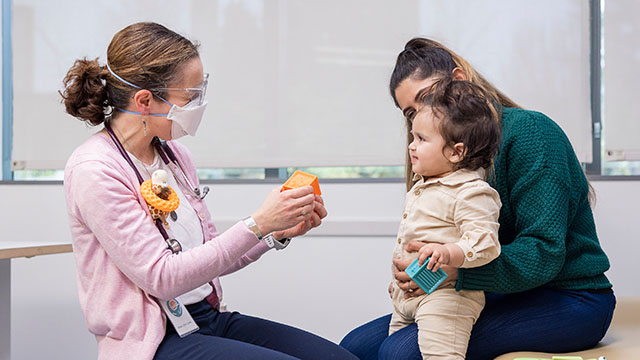Neurofibromatosis (NF)
Contact the Neurosciences Center
What is neurofibromatosis?
Neurofibromatosis (NF) is a group of genetic conditions that cause tumors to grow along the body’s nerves or under the skin. Almost always the tumors are not cancer (benign). Neurofibromatosis is pronounced NOOR-oh-FY-broh-muh-TOH-sis.
NF is present at birth, but its effects may not appear until later in childhood or young adulthood. The symptoms of NF can vary widely from child to child. There is no cure, but expert medical care can reduce and manage the effects.
Types of neurofibromatosis
Most children with NF have neurofibromatosis type 1 (NF1). Another type of NF is schwannomatosis. The most common subtype of schwannomatosis is NF2-related schwannomatosis, which used to be called neurofibromatosis type 2 or NF2.
In half of children with these conditions, the cause is an abnormal gene passed down from a parent. The rest of the time, the cause is a new genetic difference that was not inherited.
Neurosciences Care at Seattle Children's
Advanced treatments and complete care
- Seattle Children's has the only comprehensive center for neurofibromatosis type 1 and schwannomatosis in the Pacific Northwest. The Neurofibromatosis Program is part of our Neurosciences Center, which is ranked among the nation's top 10 pediatric neurology and neurosurgery programs by U.S. News & World Report. The most trusted experts in the field will care for your child.
- Our team tailors care to your child. We are experienced in treating the wide range of complications that may happen in different forms of NF. As your child grows, our team watches closely for early signs of problems so we can treat them right away.
- If your child needs treatment for tumors, options include surgery, targeted therapies (MEK inhibitors), chemotherapy and, rarely, radiation therapy.
- We are studying how to lessen the need for surgery with the use of new medicines. This targeted therapy blocks a protein that helps tumors grow.
- Seattle Children’s takes part in national research studies, including those offered by the Children's Oncology Group (COG)and Pacific Pediatric Neuro-Oncology Consortium (PNOC).
Support for your whole family
- Having a complex condition like neurofibromatosis or schwannomatosis can be scary and stressful for the whole family. Some families feel overwhelmed by the many complications that may happen as their child grows. Our experts keep a careful watch on your child.
- During visits, we take time to explain your child’s condition. We help you fully understand your treatment options, so you can make the choices that are right for your family.
- Our doctors, nurses, child life specialists and social workers help your child and your family through the challenges of their condition. We connect you to community resources and support groups.
- At Seattle Children's, we work with children and families from around the Northwest and beyond. We can help with financial counseling, schooling, housing, transportation, interpreter services and spiritual care. Read about our services for patients and families.
What are the symptoms of neurofibromatosis?
Symptoms of NF1, NF2-related schwannomatosis and other forms of schwannomatosis vary widely from child to child.
-
NF1 symptoms
Your child may have:
- Spots on the skin darker than your child’s normal skin color. These are called café-au-lait (English: coffee with cream) spots. They do not cause problems.
- Freckles in the armpits or groin area. These do not cause problems.
- Tiny tan bumps in the colored part of the eyes (iris). These are called Lisch nodules. They do not cause problems.
- Small tumors on or under the skin, called dermal or cutaneous neurofibromas. The tumors are not cancerous. Besides minor discomfort or itching, they rarely cause other symptoms.
- Tumors that grow inside the body or along multiple nerves, called plexiform neurofibromas. If the tumors press on nerves or organs, they can cause problems.
- Tumors along the nerve that sends signals from the eye to the brain. These are called optic pathway gliomas. In most cases, they do not cause symptoms.
- Challenges with attention span, focus, learning and the ability to share their thoughts, ideas and feelings.
- Curvature of the spine (scoliosis) or bowing of the legs.
-
NF2-related schwannomatosis symptoms
Some children with NF2-related schwannomatosis have tumors along the nerves that carry sound and balance information from the inner ear to the brain. These are called vestibular schwannomas. They may cause symptoms like:
- Ringing in the ear (tinnitus)
- Balance and coordination challenges
- Hearing loss
Other benign tumors in the spine or brain (such as meningiomas, nonvestibular schwannomas or ependymoma tumors) may cause these symptoms:
- Headaches
- Numbness or weakness in the face or other parts of the body
Your child’s vision may be affected if they have cataracts or abnormalities in the lining in the back of their eye (retina).
-
Symptoms of other types of schwannomatosis
Children who have other types of schwannomatosis have noncancerous (benign) tumors, called schwannomas. These schwannomas can form on nerves anywhere in the body. They may cause pain that is hard to manage.
In addition to pain, the tumors may cause:
- Numbness
- Tingling
- Vision changes
- Headaches
- Weakness
- Problems with peeing or pooping
Subtypes of schwannomatosis that are not NF2-related include:
- SMARCB1-related schwannomatosis
- LZTR1-related schwannomatosis
- 22q-related schwannomatosis
- Schwannomatosis NOS (not otherwise specified)
- Schwannomatosis NEC (not elsewhere classified)
How is NF diagnosed?
Experts in our NF Clinic will assess your child, starting with a physical exam.
Genetic tests to diagnose neurofibromatosis
Often we check your child’s blood to look for changes in the genes that cause NF1, NF2-related schwannomatosis or other types of schwannomatosis. Genetic testing helps us diagnose children sooner and more precisely. Identifying the specific genetic change causing your child’s condition helps us personalize their care and start the right treatment sooner. Your child’s treatment options may expand to include therapies that target a specific genetic pathway.
Our genetic counselors help you understand the pros and cons of genetic testing and explain test results. Genetic counseling can help you learn about your child’s condition and make informed decisions about treatment and family planning.
-
Diagnosing NF1
To decide if your child has NF1, doctors will:
- Look for symptoms like skin changes or small bumps
- Consider imaging studies such as MRI (magnetic resonance imaging) or X-ray
- Check for bumps on the colored part of your child’s eye (iris)
-
Diagnosing NF2-related schwannomatosis
To diagnose NF2-related schwannomatosis, doctors will examine your child and ask about any family history of the condition. Your child may have:
- Imaging studies to look for tumors in or near your child’s hearing (auditory) and balance nerves, spinal cord and brain.
- Hearing tests.
- A test to check function of the nerve that carries sound from the inner ear to the brain. This is called a brainstem auditory evoked response.
- A detailed eye exam.
-
Diagnosing other types of schwannomatosis
Types of schwannomatosis that are not NF2-related are most often diagnosed in adulthood. They can be hard to diagnose because other conditions cause similar symptoms. Your child will have MRI scans to check for tumors along nerves in their body.
Treating Neurofibromatosis Type 1
Seattle Children's Neurofibromatosis Program provides the most advanced treatment options from the nation's top leaders in neuroscience and cancer research. We give your child complete, coordinated care. There is no cure for NF1, but yearly check-ups help find problems early and treat the effects.
-
Dermal and plexiform neurofibromas
Many children with NF1 have lumps on and under their skin, called dermal neurofibromas. These do not need treatment.
Plexiform neurofibromas are tumors that grow deeper inside the body or along multiple nerves (not in the brain or spinal cord). If the tumor presses on nerves or organs, it can cause problems.
We watch closely and treat tumors that may affect your child’s ability to move, breathe, swallow, talk, see or hear. We also treat tumors that cause pain or significant disfigurement. Treatment options include:
- Surgery to remove all or part of dermal neurofibromas or plexiform neurofibromas. Surgery may not be an option if the tumor is deep in the body or if removing it risks damage to healthy nerves and tissues.
- Targeted therapies to block a protein (MEK) that causes plexiform neurofibromas to grow. These medicines are called MEK inhibitors and are taken as a pill. Research studies show MEK inhibitors shrink tumors, reduce pain and disfigurement and improve mobility.
-
Brain and Spine Tumors
Treatment options include:
- Targeted therapies (MEK inhibitors) to block a protein that causes the growth of brain and spine tumors in patients with NF1. MEK inhibitors can stabilize these tumors.
- Chemotherapy.
- Neurosurgery to remove tumors that cause symptoms. Our Brain Tumor experts lead global research on new treatments to increase cure rates and reduce side effects of therapy.
- Rarely, radiation therapy.
-
Eye care
Regular eye exams are an important part of care for NF1. About 15% of children with NF1 have tumors in the nerve behind their eye. These are called optic pathway gliomas (glee-OH-muhs). Most do not need treatment.
When the tumors affect vision, we treat them with chemotherapy or targeted therapies. Less often, we use radiation therapy. Experts in ophthalmology will care for your child if they have this type of tumor.
-
Problems affecting bones and mobility
Up to 20% of children with NF1 have a sideways curve in their spine (scoliosis). Depending on how severe your child’s curve is, treatment options may include wearing a back brace or having surgery. See how we treat scoliosis.
About 5% of children have bowing in their lower legs. For problems affecting the spine or limbs, we work with specialists in orthopedics to be sure your child gets the care they need.
If your child’s tumors affect their ability to move, physical therapists (PTs) and occupational therapists (OTs) will assess and treat them.
-
Learning, speech or behavior problems
Half of children with NF1 have problems with learning, speech or ADHD (attention deficit hyperactivity disorder).
We check your child at each visit and recommend treatments and services.
As needed, your child will see Seattle Children’s experts in:
- The relationship between the brain and your child’s behavior, learning and mood (neuropsychologists)
- The brain’s development and how it relates to behavior (developmental neuropsychiatrists)
-
Growth problems
About 30% of children with NF1 are shorter than kids of the same age. In some children, puberty may be early (precocious) or delayed. If your child has problems related to their hormones, they will get care from experts in endocrinology.
-
Problems affecting the head and face
If your child has tumors on their face or neck, we partner with the Craniofacial Center, and with you, to create a plan of care tailored to your child. These tumors may affect your child’s movement, speech, feeding and how they look. We may treat them with surgery or targeted therapies. The craniofacial team of 50 experts covers 19 different specialties. These include plastic surgeons, otolaryngologists, neurosurgeons, physical therapists (PTs) and occupational therapists (OTs).
Treating NF2-Related Schwannomatosis
If your child has NF2-related schwannomatosis, regular check-ups and imaging studies help us find problems early.
-
Tumors
We watch closely for signs that tumors might lead to problems like hearing loss, facial paralysis, disfigurement, numbness, weakness or balance issues. If tumors need treatment, your child may have surgery to remove all or part of the tumor.
We will talk with you about the pros and cons of surgery. Depending on your child’s needs, they may get care from a neurosurgeon or otolaryngologist. Most patients with NF2-related schwannomatosis will have annual brain and spine imaging.
-
Hearing
If a tumor could harm your child’s hearing, we may treat it with chemotherapy or, very rarely, radiation therapy in addition to surgery.
If a tumor causes hearing loss, treatment options include:
- A small, surgically implanted electronic device (cochlear implant) that can help give Deaf or hard-of-hearing children a sense of sound. Learn more about cochlear implants.
- An auditory brainstem implant that sends signals directly to the brain, allowing people to hear certain sounds and speech.
-
Eye care
At least once a year, we check the vision of children with NF2-related schwannomatosis. Some children with this condition develop cataracts and abnormalities of the retina at a young age. These may affect your child’s eyesight.
If your child needs treatment, we partner with experts in ophthalmology.
Treating Other Types of Schwannomatosis
If your child has schwannomatosis that is not NF2-related, treatment depends on their symptoms. Some children need surgery to remove tumors that cause pain or other problems because they press on nerves or organs. If tumors cannot be removed, your child’s team will focus on managing pain or other symptoms.
At this time, no medicine is known to be effective in treating types of schwannomatosis that are not NF2-related. We work with your child and family to best manage their symptoms.
Why choose Seattle Children's for neurofibromatosis care?
 Seattle Children’s has the only pediatric neurofibromatosis program in the region, led by a neuro-oncologist with special training in treating children with NF. We partner with your family to give your child complete, evidence-based care. Our team treats your whole child, not just their disease.
Seattle Children’s has the only pediatric neurofibromatosis program in the region, led by a neuro-oncologist with special training in treating children with NF. We partner with your family to give your child complete, evidence-based care. Our team treats your whole child, not just their disease.
Seattle Children’s is the only pediatric hospital in the Pacific Northwest that has been designated as a Comprehensive Center for both Neurofibromatosis Type 1 and Schwannomatosis by the Children’s Tumor Foundation. This national recognition is awarded to programs with neurofibromatosis expertise, comprehensive medical care and a commitment to care, research and education.
If you would like an appointment, ask your child’s primary care provider to refer you to the NF Clinic at Seattle Children’s Neurosciences Center. If you have a referral, call 206-987-2016 to make an appointment.
Providers, see how to refer a patient.
The experts you need are here
- NF is a complex condition that can affect many parts of the body. We provide full care for your child in a coordinated way. Our neuro-oncologist holds clinics jointly with experts in genetics, brain tumors, learning, neurosurgery, audiology, physical therapy and occupational therapy.
- Our Brain Tumor team is experienced with all types of brain and spinal cord tumors. We are known across the globe for our research to improve treatments.
- Seattle Children's is home to the oldest and most well-known referral center for genetic disorders in the Pacific Northwest.
-
Team approach
Our team works closely with Seattle Children’s experts in many other medical fields to give your child complete care. These include:
Contact Us
- If you would like an appointment, ask your child’s primary care provider to refer you to the NF Clinic in our Neurosciences Center.
- If you have a referral, call 206-987-2016 to make an appointment.
- Providers, see how to refer a patient. Our fax number is 206-985-3389.
- If you have any questions, please at contact us at 206-987-2016 or 844-935-3467 (toll free).
Paying for Care
Learn about paying for care at Seattle Children’s, including insurance coverage, billing and financial assistance.


